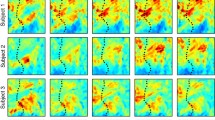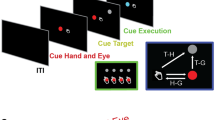Abstract
Previous work (Schieber and Hibbard, 1993) has shown that single motor cortical neurons do not discharge specifically for a particular flexion-extension finger movement but instead are active with movements of different fingers. In addition, neuronal populations active with movements of different fingers overlap extensively in their spatial locations in the motor cortex. These data suggested that control of any finger movement utilizes a distributed population of neurons. In this study we applied the neuronal population vector analysis (Georgopoulos et al., 1983) to these same data to determine (1) whether single cells are tuned in an abstract, three-dimensional (3D) instructed finger and wrist movement space with hand-like geometry and (2) whether the neuronal population encodes specific finger movements. We found that the activity of 132/176 (75%) motor cortical neurons related to finger movements was indeed tuned in this space. Moreover, the population vector computed in this space predicted well the instructed finger movement. Thus, although single neurons may be related to several disparate finger movements, and neurons related to different finger movements are intermingled throughout the hand area of the motor cortex, the neuronal population activity does specify particular finger movements.
Similar content being viewed by others
References
Caminiti R, Johnson PB, Galli C, Ferraina S, Burnod Y, Urbano A (1991) Making arm movements within different parts of space: The premotor and motor cortical representation of a coordinate system for reaching at visual targets. J. Neurosci. 11:1182–1197.
Efron B, Tibshirani RJ (1993) An Introduction to the Bootstrap. Chapman & Hall, New York.
Fisher NI, Lee AJ (1986) Correlation coefficients for random variables on a unit sphere or hypersphere. Biometrika 73:159–164.
Fortier PA, Kalaska JF, Smith AM (1989) Cerebellar neuronal activity related to whole-arm reaching movements in the monkey. J. Neurophysiol. 62:198–211.
Georgopoulos AP, Caminiti R, Kalaska JF, Massey JT (1983) Spatial coding of movement: A hypothesis concerning the coding of movement direction by motor cortical populations. Exp. Brain Res. Suppl. 7:327–336.
Georgopoulos AP, Kalaska JF, Caminiti R, Massey JT (1982) On the relations between the direction of two-dimensional arm movements and cell discharge in primate motor cortex. J. Neurosci. 2:1527–1537.
Georgopoulos AP, Kalaska JF, Crutcher MD, Caminiti R, Massey JT (1984) The representation of movement direction in the motor cortex: Single cell and population studies. In: GM Edelman, WM Cowan, WE Gall, eds. Dynamic Aspects of Neocortical Function. Wiley, New York. pp. 501–524.
Georgopoulos AP, Kettner RE, Schwartz AB (1988) Primate motor cortex and free arm movements to visual targets in threedimensional space. II. Coding of the direction of movement by a neuronal population. J. Neurosci. 8:2928–2937.
Georgopoulos AP, Schwartz AB, Kettner RE (1986) Neuronal population coding of movement direction. Science 233:1416–1419.
Hayes R, Schieber MH (1996) Human individuated finger movements: How independent are the digits? Soc. Neurosci. Abstr. 22:426 (Abstract).
Kalaska JF, Caminiti R, Georgopoulos AP (1983) Cortical mechanisms related to the direction of two-dimensional arm movements: Relations in parietal area 5 and comparison with motor cortex. Exp. Brain Res. 51:247–260.
Ruiz S, Crespo P, Romo R (1995) Representation of moving tactile stimuli in the somatic sensory cortex of awake monkeys. J. Neurophysiol. 73:525–537.
Salinas E, Abbott LF (1994) Vector reconstruction from firing rates. J. Comp. Neurosci. 1:89–107.
Sanes JN, Donoghue JP, Thangaraj V, Edelman RR, Warach S (1995) Shared neural substrates controlling hand movements in human motor cortex. Science 268:1775–1777.
Schieber MH (1991) Individuated finger movements of rhesus monkeys: A means of quantifying the independence of the digits. J. Neurophysiol. 65:1381–1391.
Schieber MH, Hibbard LS (1993) How somatotopic is the motor cortex hand area? Science 261:489–492.
Schwartz AB (1994) Direct cortical representation of drawing. Science 265:540–542.
Schwartz AB, Kettner RE, Georgopoulos AP (1988) Primate motor cortex and free arm movements to visual targets in threedimensional space. I. Relations between single cell discharge and direction of movement. J. Neurosci. 8:2913–2927.
Soechting JF, Flanders M (1997) Flexibility and repeatability of finger movements during typing: Analysis of multiple degrees of freedom. J. Comput. Neurosci. 4:29–46.
Steinmetz MA, Motter BC, Duffy CJ, Mountcastle VB (1987) Functional properties of parietal visual neurons: Radial organization of directionalities within the visual field. J. Neurosci. 7:177–191.
Young MP, Yamane S (1992) Sparse population coding of faces in the inferotemporal cortex. Science 256:1327–1331.
Author information
Authors and Affiliations
Rights and permissions
About this article
Cite this article
Georgopoulos, A.P., Pellizzer, G., Poliakov, A.V. et al. Neural Coding of Finger and Wrist Movements. J Comput Neurosci 6, 279–288 (1999). https://doi.org/10.1023/A:1008810007672
Issue Date:
DOI: https://doi.org/10.1023/A:1008810007672




